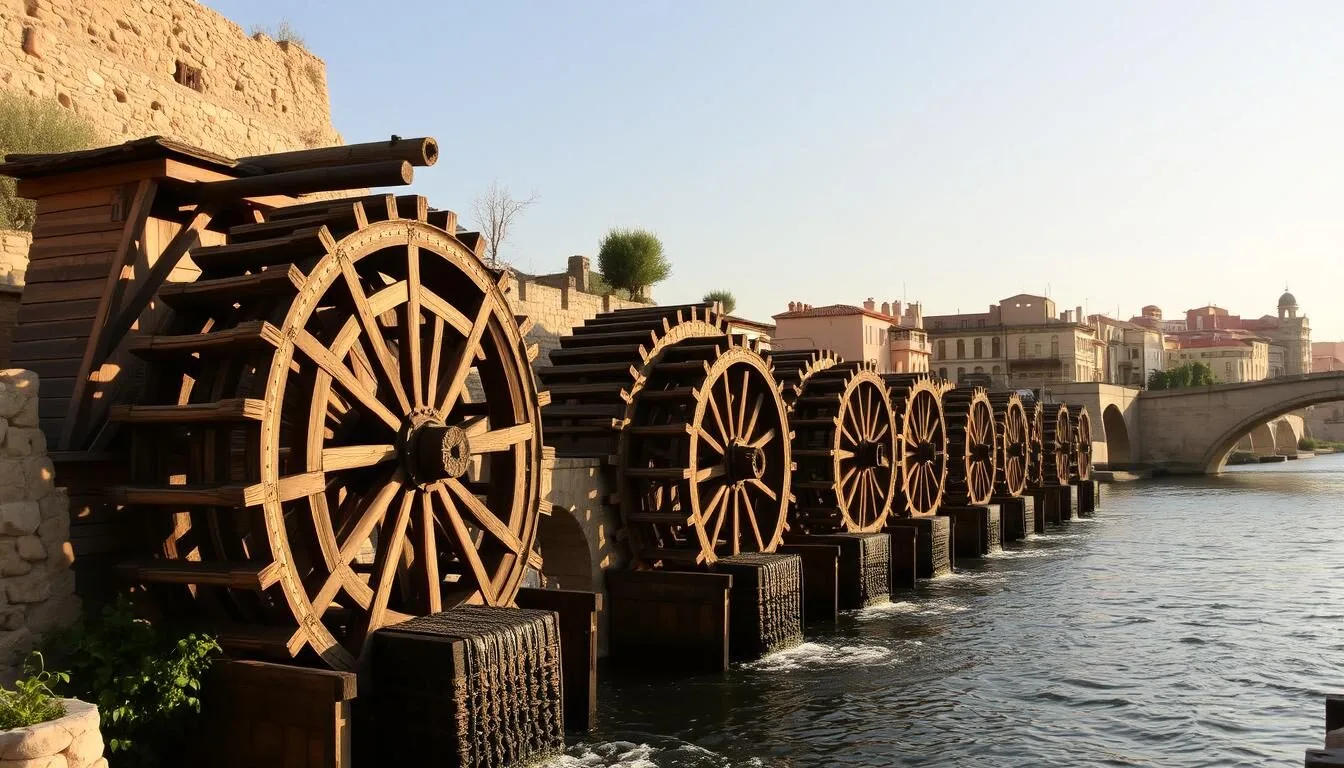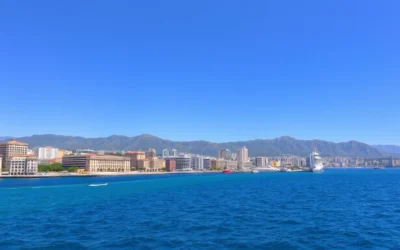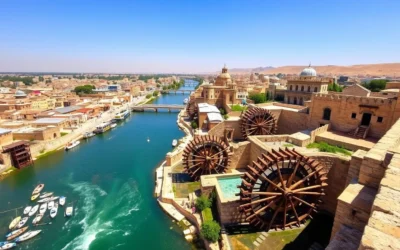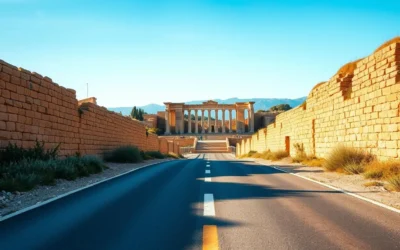✓ Accommodations✓ Flights✓ Rental Cars
Imagine a city where ancient history and vibrant culture blend seamlessly together. Hamah, a city in western Syria, is just that. With its iconic norias (water wheels) dating back to Roman times, Hamah offers a unique glimpse into the region’s rich past.
As you explore this historic city, you’ll discover the significant role it played in the Middle East‘s irrigation and agriculture along the Orontes River. With a history that spans various civilizations, from the Hittites to the Islamic Golden Age, Hamah is a treasure trove of cultural heritage waiting to be uncovered.
Whether you’re a history buff or an adventurous traveler, Hamah promises an unforgettable experience. You’ll get to explore stunning architecture, bustling souqs, and tranquil mosques, giving you a true taste of the country’s authentic culture.
Discovering the Ancient City of Hamah
The city of Hamah is a living museum, showcasing the cultural and historical heritage of the region. As you explore Hamah, you’ll uncover the layers of its rich history, shaped by numerous civilizations that once flourished there.
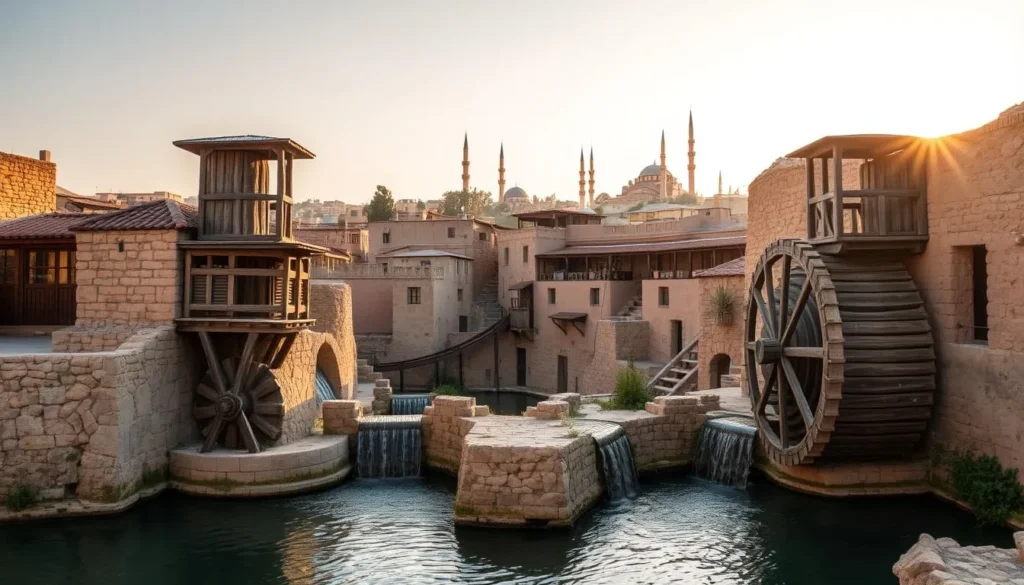
Historical Significance of Hamah in Syria
Hamah has witnessed various civilizations, from the Hittites and Romans to the Umayyads and Abbasids, each leaving their mark on the city. The city flourished during the Islamic Golden Age, becoming a hub for trade and learning. Over the years, Hamah has played a significant role in the country‘s development, with its strategic location making it an important center for cultural exchange.
- You’ll be walking in the footsteps of numerous civilizations when you visit Hamah, as the city has been continuously inhabited since ancient times.
- The city’s architecture tells the story of its past, with influences from Ottoman, Mamluk, and earlier periods visible in its mosques, traditional houses, and public buildings.
- Hamah’s historical significance extends beyond Syria, as it was part of various empires that shaped the history of the entire Middle East.
As you explore the city’s historical sites, you’ll notice how Hamah’s people have preserved their cultural heritage despite facing various challenges over the years. The city’s resilience is a testament to the strength and determination of its people.
Geographical Setting and Cultural Importance
Hamah’s strategic location along the Orontes River made it an important trade center throughout history, connecting major cities and facilitating cultural exchange across the region. The city’s geographical setting has played a crucial role in its development, making it a significant cultural hub.
As you visit Hamah, you’ll experience the city’s cultural importance firsthand, with its traditional crafts, cuisine, and social customs offering a glimpse into Syrian heritage. The city’s cultural significance is not limited to Syria; it has connections to the broader Middle East and beyond, including influences that can be compared to those found in the United States and even Saudi Arabia.
- The city’s cultural importance is evident in its traditional crafts, cuisine, and social customs that have been preserved through generations.
- You’ll notice how the city’s architecture and cultural practices have been influenced by its geographical setting and historical significance.
Planning Your Visit to Hamah
As you prepare for your trip to Hamah, Syria, it’s essential to plan your visit carefully to make the most of your time in this ancient city. For first time visitors, understanding the best times to visit, how to get around, and where to stay can significantly enhance your travel experience.
Best Time to Visit Hamah
Hamah, like much of the country, experiences a Mediterranean climate with hot summers and mild winters. The best times to visit are during the spring (April-May) and fall (September-October), when the weather is pleasant, making it ideal for exploring the historical sites and enjoying the scenic views along the Orontes River. These periods offer comfortable days for walking around the city.
- Spring (April-May) brings mild temperatures, making it perfect for sightseeing.
- Fall (September-October) offers a similar climate, ideal for enjoying the outdoors.
Getting Around the City
Hamah is relatively compact, and many of its attractions are within walking distance of each other. For longer distances, people often use service taxis (shared taxis), which are an affordable and efficient way to get around. Having the right information about these transportation options can make your visit smoother.
- Walking is a great way to explore the city’s historical areas.
- Service taxis are available for longer distances within the city.
Accommodation Options in Hamah
When it comes to choosing where to stay, Hamah offers a range of hotels and guesthouses. The area around the Orontes River is a popular option due to its picturesque views and lively atmosphere, especially in the evenings. For a more authentic experience, consider staying in the old city section, where you can immerse yourself in traditional Syrian culture. Before booking, it’s a good idea to check a reliable website for the latest reviews and information.
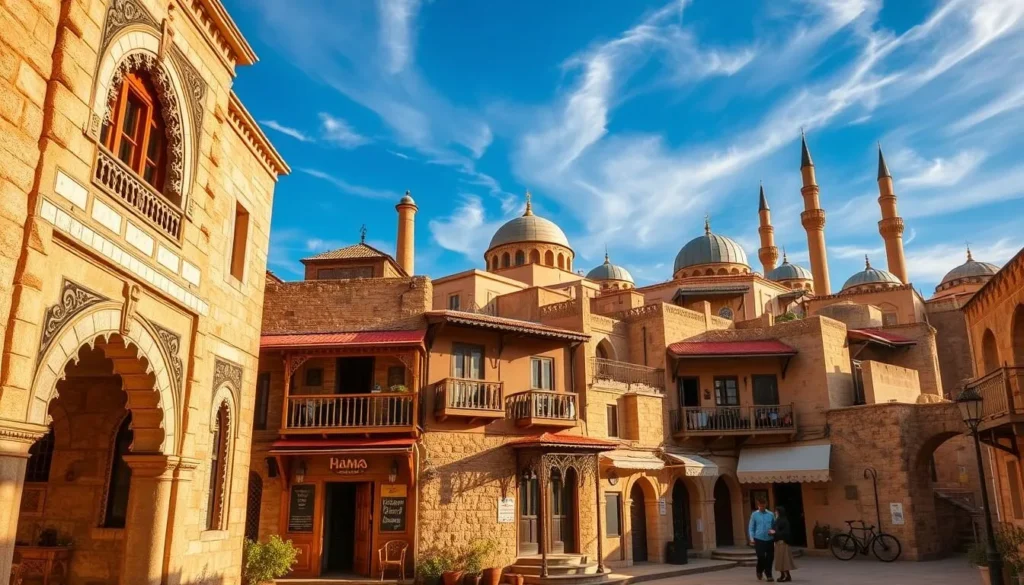
- The Orontes River area offers scenic views and a lively atmosphere.
- The old city section provides an authentic cultural experience.
By planning your visit to Hamah carefully, you can ensure a memorable and enjoyable trip to this historic Syrian city.
The Iconic Norias of Hamah
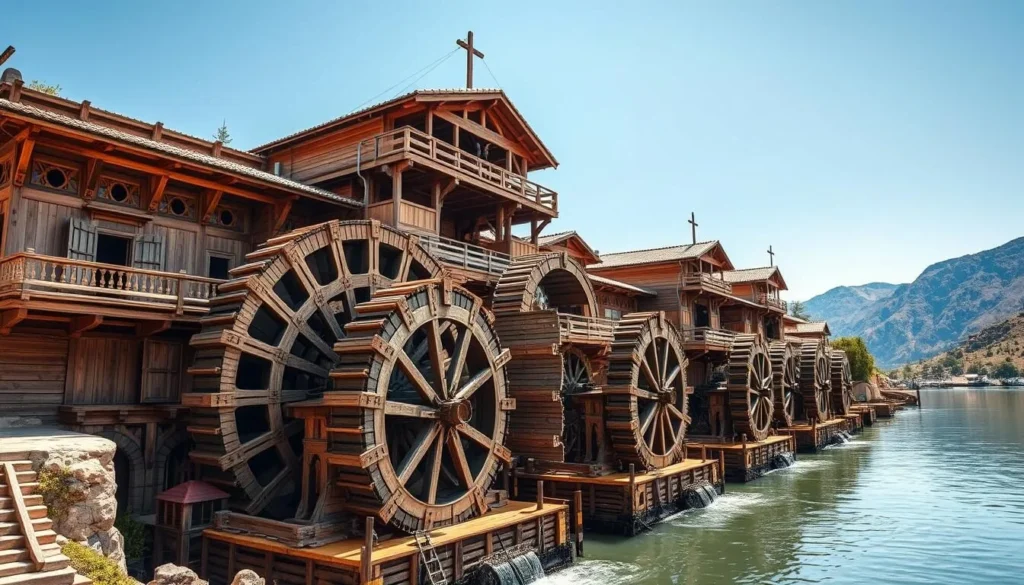
As you stroll along the Orontes River, the majestic Norias of Hamah come into view, showcasing the ingenuity of ancient civilizations. These massive wooden waterwheels, some measuring up to 20 meters in diameter, have become the defining symbol of Hamah and represent one of the best examples of ancient water management technology in the Middle East.
History and Engineering of the Ancient Waterwheels
The Norias of Hamah have a rich history dating back to the Byzantine era, although they were perfected during Islamic times. These engineering marvels were constructed to harness the power of the Orontes River, lifting water to aqueducts that distributed it to fields and gardens throughout the region. The ingenuity of past civilizations is evident in the sustainable solutions they created for agricultural challenges.
The construction of the Norias is a testament to the skill and craftsmanship of the people who built them. Using locally sourced wood and traditional techniques, these waterwheels were designed to be durable and efficient, with some still operational today.
Best Spots to View and Photograph the Norias
For the best quality photographs, you’ll want to visit the Norias during the golden hour before sunset when the light bathes the wooden structures in a warm glow and creates stunning reflections on the water below. Several viewing platforms along the river offer ideal vantage points to observe these ancient mechanisms in action.
The Al-Mohamadiyya Noria is particularly impressive due to its size and the distinctive creaking sound it makes while turning. It’s a great spot to spend some time observing the Noria and taking in the historical significance of the area.
As you explore the Norias, you’ll be amazed by their scale and the role they played in Hamah’s agricultural past. The combination of construction ingenuity and historical significance makes the Norias a must-visit attraction in Hamah.
Exploring the Orontes River
Strolling along the Orontes River, you’ll discover the perfect blend of natural beauty and cultural heritage that defines Hamah. The river, which flows gently through the city, is a haven for both locals and visitors, offering a serene escape from the bustling streets of Hamah.
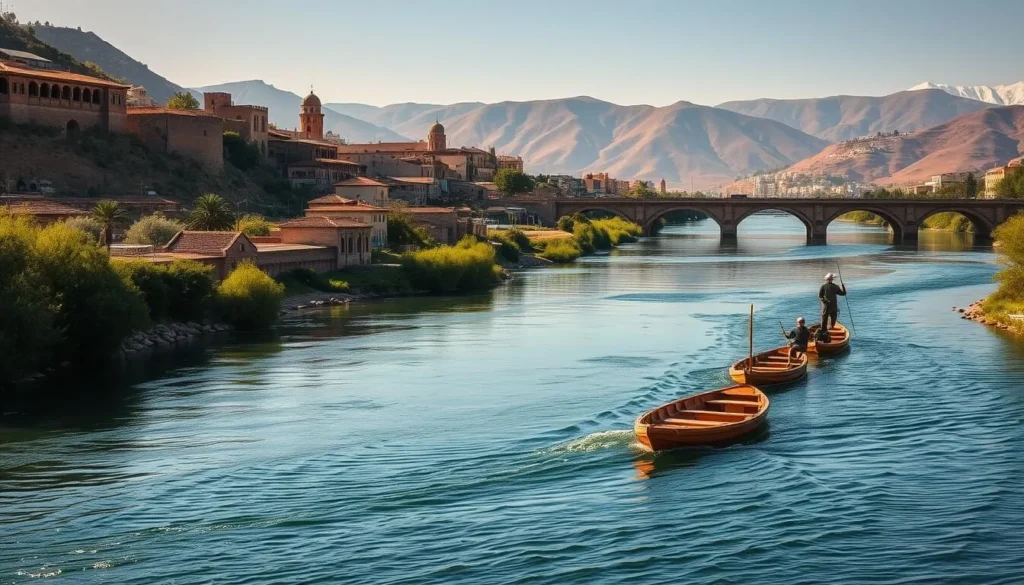
Riverside Walks and Scenic Views
The Orontes River is the lifeblood of Hamah, providing a refreshing space where people gather to enjoy the scenic beauty. As you stroll along the riverside promenades, you’ll be treated to panoramic views of the city’s skyline, with minarets and ancient buildings creating a picturesque backdrop against the flowing water.
The riverside atmosphere is particularly enchanting in the evening hours when families come out to socialize, creating a lively yet relaxed atmosphere that gives you a genuine taste of daily life in Hamah. You’ll find the Orontes River to be a perfect spot to unwind and appreciate the natural beauty surrounding you.
Cafes and Relaxation Spots Along the Orontes
As you explore the Orontes River, you’ll discover numerous cafes and tea houses dotting the riverbanks. Here, you can sample traditional Syrian refreshments while watching the famous Norias turn slowly in the current. The interplay of light on the water, especially during sunset, creates magical opportunities to capture the essence of this historic Syrian city in ways that rival scenic spots in the United States and other well-known destinations in the Middle East.
These riverside cafes offer a unique chance to relax and soak in the local vibe, making your visit to Hamah even more memorable. Whether you’re looking to enjoy a quiet moment or simply take in the views, the Orontes River provides a wonderful setting for all.
Hamah’s Religious Heritage
As you explore Hamah, you’ll discover a rich tapestry of religious heritage that has shaped the city’s identity over centuries. The city’s religious landscape is a testament to its complex history and the diverse faiths that have coexisted within its walls.
Hamah’s religious sites are not just places of worship; they are also architectural marvels and historical landmarks that offer insights into the city’s past. The presence of various religious traditions is evident in the city’s many mosques, churches, and other sacred spaces.
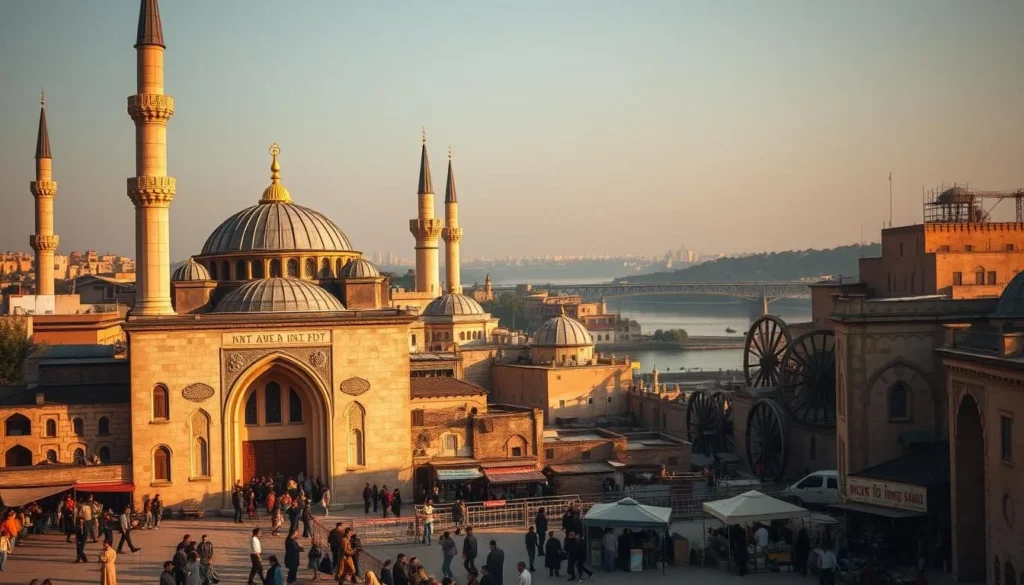
The Great Mosque of Hamah
The Great Mosque of Hamah is a stunning example of Islamic architecture, with a history dating back to the 8th century. This mosque has served as a spiritual center for the local community for centuries, despite the political tensions under the Assad regime.
As you explore the mosque, you’ll notice the beautiful blend of architectural styles reflecting different historical periods, from the original construction to later Ottoman additions and renovations. The mosque’s serene courtyard offers a peaceful retreat from the bustling city, with its ancient stone arches and central ablution fountain creating a contemplative atmosphere.
The Great Mosque is not only a place of worship but also a symbol of the country’s enduring religious traditions. It stands as a testament to the history and cultural identity of Hamah’s people.
| Feature | Description | Significance |
|---|---|---|
| Architectural Style | Blend of Islamic and Ottoman styles | Reflects the historical and cultural influences on the region |
| Courtyard | Serene space with ancient stone arches and ablution fountain | Provides a peaceful retreat for worshippers and visitors |
| Historical Significance | Dating back to the 8th century | Embodies the rich history and cultural heritage of Hamah |
Other Significant Religious Sites
Beyond the Great Mosque, Hamah is home to several other significant religious sites that showcase the diverse spiritual heritage and historical presence of various faiths in the region. These sites offer insights into how faith has shaped the cultural identity of Hamah’s people throughout history.
As you visit these religious sites, you’ll gain a deeper understanding of the community’s traditions and the role that faith has played in shaping the city’s history. The presence of different religious sites is a testament to the community’s tolerance and coexistence.
From historic churches to other mosques, each site has its unique story and architectural style, contributing to the rich tapestry of Hamah’s religious heritage. The community has come together to preserve these sites, ensuring their significance is not lost to time.
Historical Landmarks in Hamah
Hamah is a city steeped in history, with landmarks that showcase its rich cultural heritage. One of the most significant historical sites is the Citadel, a fortress that has witnessed centuries of turmoil and transformation.
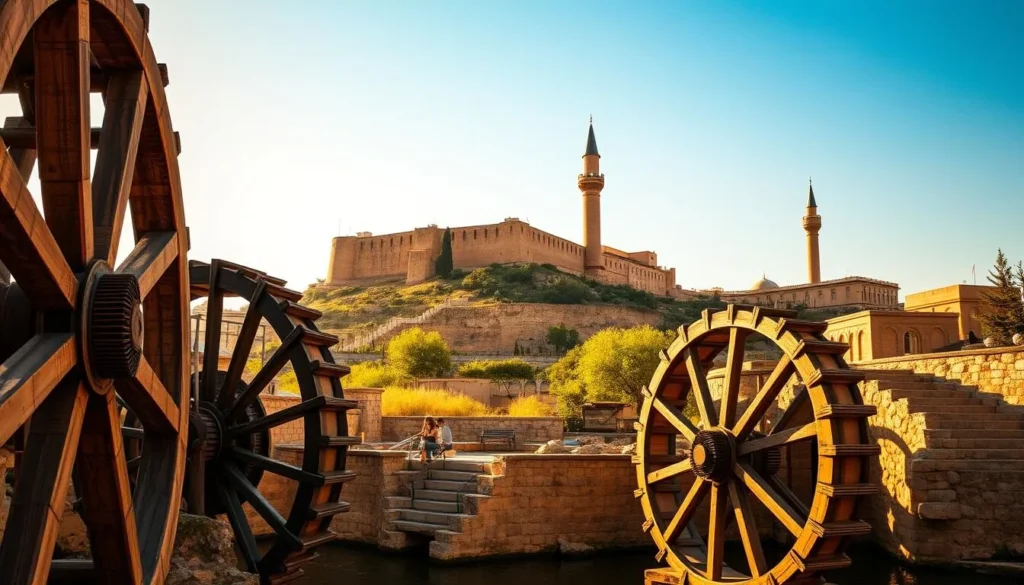
The Citadel, perched atop a hill, offers breathtaking views of the city and the Orontes River. Visitors can explore the Citadel and imagine the lives of the people who once walked the halls.
The Citadel of Hamah
The Citadel is a testament to the ingenuity and craftsmanship of the people who built it. Its imposing walls and towers are a reminder of the city’s strategic importance throughout history.
| Landmark | Description |
|---|---|
| Citadel of Hamah | Ancient fortress |
| Qasr al-Husn | Historic palace |
Museums and Cultural Institutions
Hamah’s museums and cultural institutions are essential stops for anyone looking to understand the city’s role in the country’s history. These institutions preserve and showcase the rich cultural heritage of Hamah, offering insights into its past and present.
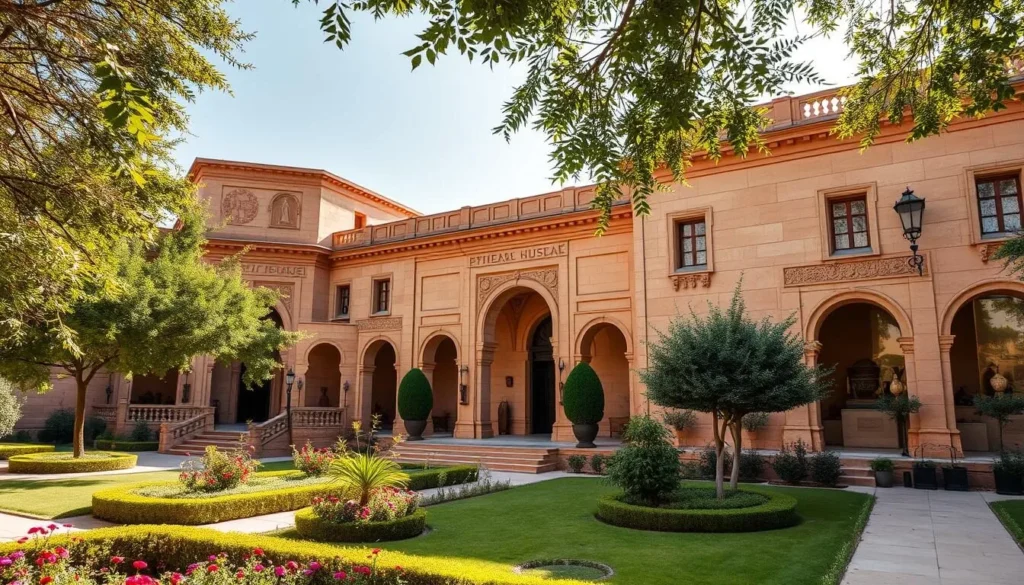
Hamah Museum: A Window to the Past
The Hamah Museum houses an impressive collection of artifacts that tell the story of the region’s past, from prehistoric times through the Roman period and Islamic era. The exhibits include pottery, jewelry, tools, and household items that humanize ancient civilizations, giving you a glimpse into how ordinary people lived throughout different periods of the country’s history.
- The museum’s collection rivals those found in smaller museums in the United States or New York, showcasing a wide range of historical artifacts.
- As you explore the exhibits, you’ll gain insight into the daily lives of ancient people and their cultural practices.
- The museum plays a vital role in preserving cultural heritage and educating both locals and visitors about Hamah’s significant contributions to world history and art.
Cultural Centers and Galleries
Beyond the main museum, you’ll discover various cultural centers and galleries throughout Hamah that showcase contemporary Syrian art and host community events. These institutions provide spaces where you can interact with local artists and intellectuals, gaining a deeper understanding of how they interpret their heritage and current realities through various artistic expressions.
- These cultural institutions are vital for the local community, offering a platform for artistic expression and cultural exchange.
- By attending events at these centers, you’ll experience the vibrant creative scene that persists in Hamah despite challenging circumstances.
- The galleries showcase a range of contemporary art, reflecting the city’s ongoing cultural evolution and its role in the broader cultural landscape.
By visiting Hamah’s museums and cultural institutions, you’ll not only learn about the city’s history but also experience its vibrant cultural scene, understanding the significant role it plays in the country’s cultural heritage.
Traditional Architecture of Hamah
Strolling through Hamah’s older neighborhoods, you’ll be struck by the beauty and craftsmanship of the traditional houses. These homes are not just relics of the past; they are vibrant examples of the city’s cultural and architectural heritage.
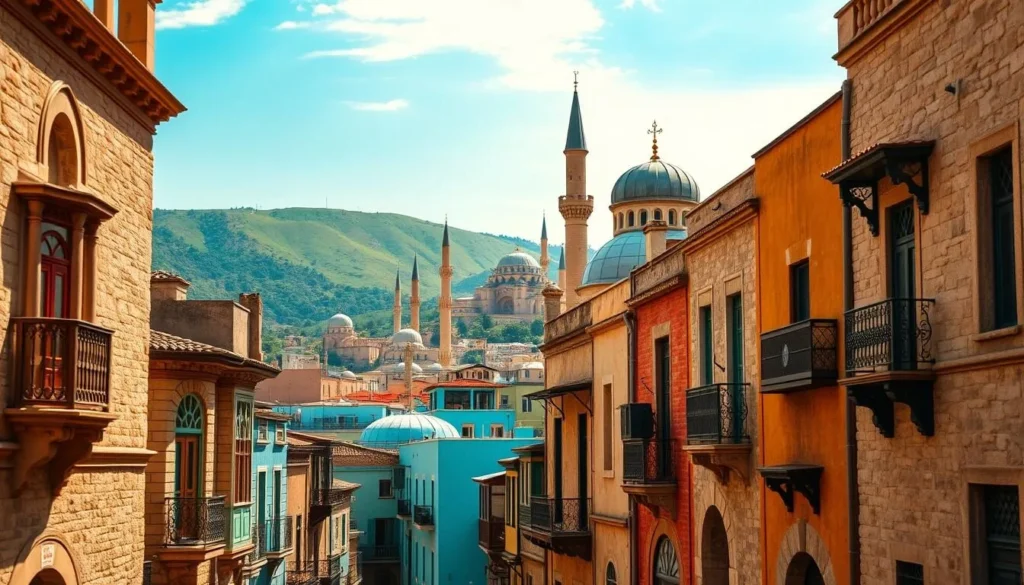
Historic Houses and Their Unique Features
Hamah’s traditional houses are renowned for their best quality architectural craftsmanship, featuring elements like central courtyards, ornate wooden balconies, and intricate stonework. These features not only showcase the skill of local craftsmen but also reflect the social values and way of life of Hamah’s people throughout history.
- The houses were ingeniously designed to provide comfort in the local climate, with thick walls for insulation and strategic ventilation.
- Spaces were designed for extended families, with areas for receiving guests and private family quarters.
- The architecture reflects the history and cultural influences of the region, from ancient civilizations to Ottoman-era buildings.
| Feature | Description | Benefit |
|---|---|---|
| Central Courtyards | Open spaces within the house | Provides natural light and ventilation |
| Ornate Wooden Balconies | Intricately carved wooden structures | Adds aesthetic appeal and provides shaded areas |
| Intricate Stonework | Detailed carvings on stone surfaces | Reflects the craftsmanship and cultural heritage |
Architectural Walking Tour Recommendations
To fully appreciate Hamah’s traditional architecture, consider embarking on an architectural walking tour. These tours take you through different historical periods, showcasing how Hamah’s architecture evolved while maintaining its distinctive local characteristics. You’ll see how the city’s urban fabric compares to other historic cities, such as those in Syria and beyond, including comparisons to historic districts in New York.
By following these recommended walking tours, you’ll benefit from a deeper understanding of Hamah’s construction techniques and architectural styles. The tours connect major landmarks with lesser-known architectural gems, providing a comprehensive view of the city’s heritage.
Markets and Shopping Experiences
Hamah is a city that is steeped in tradition and culture, and its markets are a reflection of this rich heritage. The city’s markets offer a unique shopping experience that combines traditional Syrian culture with modern flair. You’ll find a wide range of goods, from intricately crafted handicrafts to fresh produce and local delicacies.
Souq al-Hamidiyah: A Shopper’s Paradise
One of the must-visit destinations in Hamah is the Souq al-Hamidiyah. This bustling marketplace is a shopper’s paradise, where you can find everything from handmade jewelry to traditional clothing. As you browse the stalls, you’ll be surrounded by the sights and sounds of the local culture. The market is also a great place to try local street food, with vendors offering a range of delicious snacks and refreshments.
| Product | Description | Price Range |
|---|---|---|
| Handmade Jewelry | Intricately designed pieces made with local materials | $20-$100 |
| Traditional Clothing | People’s traditional attire, reflecting the country’s rich cultural heritage | $30-$150 |
| Local Delicacies | Traditional Syrian sweets and snacks | $5-$20 |
When shopping in Hamah, be sure to explore the local markets and bazaars, where you can find unique souvenirs and experience the local culture. The city’s markets are a great place to try local cuisine, with a range of traditional dishes and snacks available.
Parks and Recreational Spaces
Parks in Hamah are not just spaces; they’re vibrant community hubs where locals gather to relax, socialize, and enjoy the outdoors. These green areas are essential to the city’s landscape, providing a tranquil escape from the urban bustle.
Al-Midar Park: A Local Favorite
Al-Midar Park stands out as a refreshing green oasis in the urban landscape of Hamah. It’s a place where local people gather for relaxation, social interaction, and community events, much like public parks in cities like New York or in the United Arab Emirates. You’ll find families picnicking, friends meeting for conversation, and children playing in designated areas, offering authentic cultural insights that tourist attractions often miss.
The park’s thoughtfully designed landscape features shaded seating areas, walking paths, and seasonal flower displays, creating a peaceful atmosphere away from the bustling city streets. It’s an ideal spot for people-watching and experiencing everyday Syrian life.
Other Green Spaces in Hamah
Beyond Al-Midar, Hamah is dotted with several smaller green spaces that serve as neighborhood gathering spots. Each of these parks has its own character and regular visitors who consider them extensions of their living space. They often host small-scale cultural performances and seasonal celebrations, making them vibrant community event spaces.
| Park Name | Features | Community Events |
|---|---|---|
| Al-Midar Park | Shaded seating, walking paths, seasonal flowers | Picnics, cultural performances |
| Al-Khair Park | Playgrounds, picnic areas | Children’s festivals, family gatherings |
| Al-Waha Park | Walking trails, scenic views | Morning walks, community meetings |
These recreational areas not only provide a space for relaxation but also foster a sense of community among the residents. Whether you’re looking to unwind or experience local culture, Hamah’s parks are a great place to start.
Culinary Experiences in Hamah
As you explore Hamah, you’ll discover a world of flavors that define Syrian cuisine. The city’s culinary heritage is deeply rooted in its history and the agricultural abundance of the surrounding countryside. You’ll find that the local cuisine is characterized by its rich flavors, aromas, and the use of fresh, locally sourced ingredients.
Traditional Syrian Dishes to Try
Hamah’s culinary scene offers a variety of traditional Syrian dishes that are sure to delight your taste buds. You’ll have the opportunity to try kibbeh, a dish made from minced meat and bulgur wheat, often served raw or fried. Another specialty is muhammara, a spicy red pepper and walnut spread that’s both flavorful and nutritious. Mezze platters, featuring a selection of small dishes like hummus, tabbouleh, and falafel, are also a staple of Syrian cuisine.
The local cuisine in Hamah is not just about the food; it’s also about the community. Dining is often a communal experience, where meals bring people together, and restaurants serve as gathering places for friends and family to share food and conversation. You’ll find that many restaurants in Hamah take pride in preserving traditional recipes passed down through generations, using ingredients that connect modern diners with the country‘s agricultural traditions and seasonal rhythms.
| Dish | Description | Key Ingredients |
|---|---|---|
| Kibbeh | Minced meat with bulgur wheat, often served raw or fried | Meat, bulgur wheat, spices |
| Muhammara | Spicy red pepper and walnut spread | Red peppers, walnuts, breadcrumbs, spices |
| Mezze Platters | Selection of small dishes | Hummus, tabbouleh, falafel, etc. |
Best Restaurants and Eateries
When it comes to dining in Hamah, you’ll find a range of options to suit every taste and budget. For the best quality traditional Syrian cuisine, consider visiting restaurants that are known for their commitment to preserving local culinary traditions. Some eateries specialize in specific dishes, while others offer a wide range of Syrian favorites. You’ll have the chance to dine in establishments that have been serving the community for years, providing a genuine taste of Syrian hospitality.
While exploring Hamah, you might notice that the flavors and dishes can be reminiscent of cuisine from other parts of the world, such as South Africa or the Mediterranean. However, Syrian cuisine has its unique twist, thanks to the blend of spices and preparation methods that have been perfected over time. Whether you’re in the mood for something familiar or looking to try something new, Hamah’s restaurants are sure to provide a memorable dining experience.
Day Trips from Hamah
With its strategic location, Hamah allows travelers to easily venture out and experience the best of what the surrounding region has to offer. The area is rich in history, culture, and natural beauty, making it an ideal place for day trips that can enrich your travel experience.
As you plan your day trips from Hamah, you’ll find that the region is dotted with historical sites and picturesque towns that are just a short drive away. Two of the most compelling destinations are the ancient ruins of Apamea and the scenic town of Masyaf, both offering unique insights into the region’s past and present.
Ancient Ruins of Apamea
One of the most fascinating day trips you can take from Hamah is to the ancient ruins of Apamea. Located just a short drive away, Apamea boasts one of the longest colonnaded streets in the Roman world, stretching over 2 kilometers. The site rivals famous archaeological sites in Saudi Arabia and the United Arab Emirates in terms of its historical significance and grandeur.
As you explore Apamea, you’ll be struck by the impressive scale and preservation of its construction. The theater, agora, and bath complexes that served thousands of people during the height of Roman influence in the region are still remarkably intact. Walking through the site, you can imagine the grandeur of this once-thriving city, with its monumental architecture and bustling streets.
The significance of Apamea lies not only in its architecture but also in its historical context. As a major city in the Roman province of Syria, Apamea played a crucial role in the region’s cultural and economic landscape. Visiting Apamea provides a unique opportunity to step back in time and experience the history of the region firsthand.
The Scenic Town of Masyaf
For a refreshing contrast to the urban environments, consider a day trip to the scenic town of Masyaf. Perched dramatically on a hillside, Masyaf’s medieval castle is a sight to behold, surrounded by lush countryside that showcases the natural beauty of this part of the country. The town offers a serene atmosphere, perfect for those looking to escape the hustle and bustle of city life.
Masyaf is not just a pretty face; it also has a rich history, with its castle being a significant historical landmark. The town provides insights into how smaller cities and settlements functioned in relation to larger urban centers like Hamah, creating a more complete picture of historical development and cultural connections across Syria.
Both Apamea and Masyaf can be comfortably visited within one or two days, giving you the flexibility to return to Hamah in the evening or extend your exploration of these fascinating destinations in the surrounding region. These day trips not only enhance your understanding of the region’s history and culture but also offer a chance to appreciate the natural beauty and diversity of the Syrian landscape.
Hamah, Syria: Best Things to Do for History Enthusiasts
For history enthusiasts, Hamah, Syria, is a treasure trove of ancient sites and monuments that tell the story of the city’s rich past. As you explore this ancient city, you’ll uncover the layers of history that have shaped Hamah into what it is today.
Al-Muhajirin Cemetery and Historical Sites
The Al-Muhajirin Cemetery is a poignant reminder of Hamah’s complex history. As you walk through this historic burial ground, you’ll encounter monuments that survived the turbulent periods of the Assad regime, providing physical connections to the past that complement the historical narratives you’ll hear from locals. The gravestones and mausoleums here tell stories of notable people, families, and events that shaped the city’s development.
You’ll find that Al-Muhajirin Cemetery offers a window into Hamah’s past, with stories of ordinary people who lived, worked, and worshipped in this part of the country. The cemetery is a significant historical site that provides insights into the city’s cultural heritage.
Tracing Hamah’s Rich Past Through Its Monuments
Hamah’s monuments collectively illustrate the city’s role in regional and world history, from ancient trade routes to the Islamic golden age and beyond. You’ll discover that many of Hamah’s historical sites have been documented and studied by archaeologists and historians from institutions in the United Kingdom and other countries, contributing to our understanding of Middle Eastern urban development.
The layered history visible in Hamah’s monuments allows you to trace the influence of different civilizations and cultural traditions, giving you insights into how ordinary life was lived throughout different historical periods in this part of the country. As you explore these sites, you’ll gain a deeper understanding of Hamah’s rich past and its significance in the world.
Under the Assad regime, Hamah experienced significant historical events that shaped the city. Understanding these events and their impact on the city and its people is crucial to appreciating Hamah’s complex history.
Family-Friendly Activities in Hamah
Hamah, a city steeped in history and culture, is an ideal destination for families looking to create lasting memories together. With its rich heritage and welcoming atmosphere, Hamah offers a unique blend of traditional and modern attractions that cater to visitors of all ages.
The city’s scenic Orontes River is a major draw, offering a serene setting for families. The riverbanks are lined with parks and green spaces, providing ample opportunities for picnics and relaxation. The sound of the water wheels, known as noria, adds to the ambiance, creating a mesmerizing experience for children and adults alike. You can take a leisurely walk along the riverbank, enjoy a family picnic, or simply sit back and watch the noria in action.
Kid-Friendly Attractions and Spaces
Many of the city’s attractions are suitable for families, offering a range of activities that cater to different ages. The city’s museums are a great place to start, with interactive exhibits that make learning fun. The city’s historical landmarks are also worth visiting, with many being stroller-friendly.
Educational Experiences
The city’s museums and cultural events provide a wealth of educational experiences for young travelers. Visitors can explore the city’s ancient past, learn about its cultural heritage, and gain a deeper understanding of the local way of life.
Practical Tips for Visiting Hamah
As you prepare to visit Hamah, Syria, being aware of the practical aspects can greatly enhance your travel experience. Understanding the local culture, being mindful of safety, and knowing your transportation options are crucial for a smooth trip.
Safety Considerations and Cultural Etiquette
When traveling to Hamah for the first time, it’s essential to dress modestly out of respect for local customs. Clothing that covers shoulders and knees for both men and women is recommended, especially when visiting religious sites or conservative communities. Learning a few basic Arabic phrases can go a long way in building rapport with local people, who often appreciate visitors making an effort to bridge cultural and language differences.
Being aware of regional events and political situations that might affect travel in the Middle East is also crucial. Conditions can change rapidly, and staying informed is one way to ensure your safety while exploring this fascinating region. When photographing people or religious sites, always ask permission first as a sign of respect for local customs and privacy concerns.
- Research current entry requirements and obtain necessary visas before traveling to Syria, as regulations can vary based on your country of origin.
- Dress modestly and respect local customs, especially when visiting religious sites.
- Learn basic Arabic phrases to interact with locals.
- Stay informed about regional events and political situations.
Transportation and Accessibility Information
For transportation across Syria to Hamah, you have several options, including buses from Damascus International Airport, shared taxis from major cities like Aleppo, or private transportation arranged through your hotel’s website. Understanding the complex political history of the region helps provide context for your visit, as Syria’s relationships with neighboring countries like Saudi Arabia and its role in Middle East politics have shaped many aspects of life that you’ll observe during your time in Hamah.
When navigating Hamah, be prepared for occasional power outages or internet connectivity issues, which are part of daily life in many parts of Syria due to infrastructure challenges resulting from years of conflict and the ongoing presence of the Assad regime. The best hotels for 2025 can be found near the Orontes River or in the old city, with options ranging from budget guesthouses to mid-range hotels that serve as comfortable bases for exploring the city.
- Use buses, shared taxis, or private transportation to reach Hamah.
- Be prepared for infrastructure challenges like power outages.
- Choose accommodations near the Orontes River or in the old city for convenience.
Conclusion: Making the Most of Your Hamah Experience
As you reflect on your journey to Hamah, it’s clear that this city offers a unique blend of history, culture, and natural beauty. From the ancient Norias to the vibrant markets, every aspect of Hamah tells a story of a rich past and a resilient people. Your visit to Hamah is not just a trip; it’s an immersive experience into the heart of Syria’s heritage.
The city’s ability to preserve its historical landmarks, such as the Great Mosque and the Citadel, amidst the challenges it faces, is a testament to the strength and determination of its people. As you wander through the streets, the blend of old and new, tradition and modernity, creates a fascinating tapestry that is quintessentially Hamah.
Your interactions with the locals, the warmth of their hospitality, and the eagerness to share stories and traditions will leave a lasting impression. Whether you’re exploring the ancient ruins, enjoying the serene landscapes along the Orontes River, or simply soaking up the atmosphere in a local café, Hamah offers a depth of experience that is both enriching and unforgettable.
As you plan your trip or reminisce about your visit, remember that Hamah is more than just a destination; it’s a gateway to understanding the complexities and the beauty of the region. The memories you create here, the people you meet, and the experiences you have will stay with you, influencing your perspective and broadening your understanding of the world.
In conclusion, Hamah is a city that embodies the spirit of Syria, with its rich history, resilient people, and vibrant culture. Visiting Hamah is not just about seeing a new place; it’s about experiencing the essence of Syrian hospitality, history, and culture. As you look back on your journey, you’ll find that Hamah has left a lasting mark on your heart, inviting you to return and continue exploring the depths of this incredible city.
—
The above is subject to change.
Check back often to TRAVEL.COM for the latest travel tips and deals.
